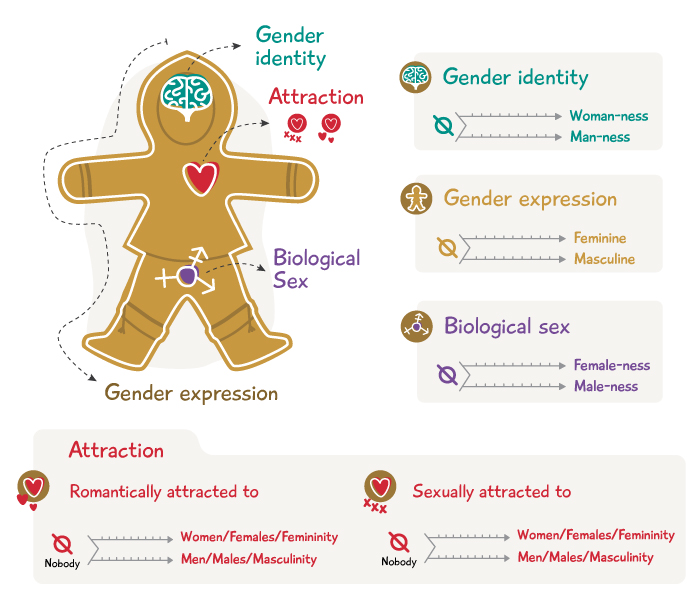
Sex
There is a difference between a person’s sex and gender. Sex refers to the biological label – female, male, or intersex - that a person is assigned at birth by a doctor based on the genitals and chromosomes a person is born with.
Gender
While sex is a biological term, gender is a social and cultural term. Gender refers to how a person’s identity relates to society’s understanding of what it means to be a woman, man, neither, or anywhere else along the gender spectrum.
Gender Identity
Gender identity refers to each person’s internal and individual experience of gender. Gender identity is a person’s sense of being a woman, a man, both, neither, or anywhere along the spectrum of gender. A person’s gender identity might be the same as or different from the sex they were assigned at birth.
Gender Expression
Gender expression refers to how a person publicly presents or expresses their gender. Gender expression can include behaviour and outward appearance such as clothing, hair, make-up, body language and voice.
Gender roles are the social norms of what people expect and see as “masculine” or “feminine”. From birth, people see and understand gender roles through their family, media, and other parts of society. Gender roles are rooted in culture, so ‘traditional’ gender roles for Inuit and non-Inuit vary in many ways. Gender roles also evolve over time, influenced by changes in technology, attitudes and values, culture and language, and other factors.
During the teen years, young people start to question and choose various gender roles. They may choose to challenge the more ‘traditional’ roles. For example, teen boys may find they enjoy cooking, sewing, or playing with small children; teen girls may excel in science, sports, or hunting.
When people feel pressure to conform to certain gender roles, it can be difficult. It is important for people to pursue activities and interests that fulfill them as a person. If you have been struggling gender or gender identity and expectations, you are not alone. It may help to talk to a trusted friend, family member, teacher, or counsellor. For further support visit sexuality support resource page.
While the following terms include basic definitions, it is important to remember that gender is personal, and each person is going to understand and define their gender in their own way.
| Cisgender | A person whose gender identity is the same as their sex assigned at birth. |
| Transgender | A person whose gender identity differs from their sex assigned at birth. |
| 2-Spirit | A cultural term used by some Indigenous people to describe having a female and male spirit. This may relate to their spirituality, sexual orientation, and gender identity. |
| Nonbinary | An umbrella term for all genders other than female/male and woman/man. |
| Genderqueer | A term commonly used by people who do not identify or express their gender within the gender binary. |

 Learn more
Learn more